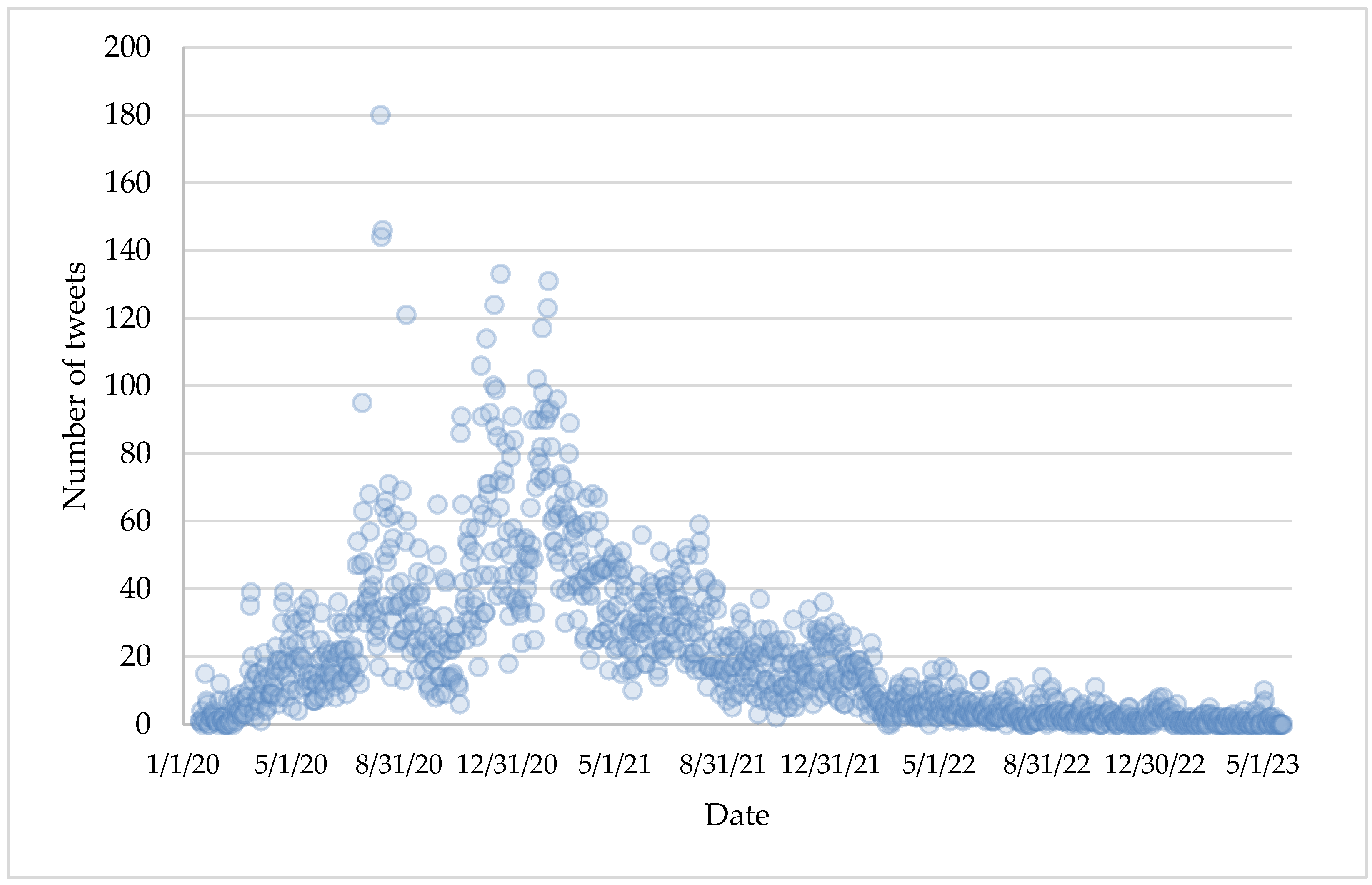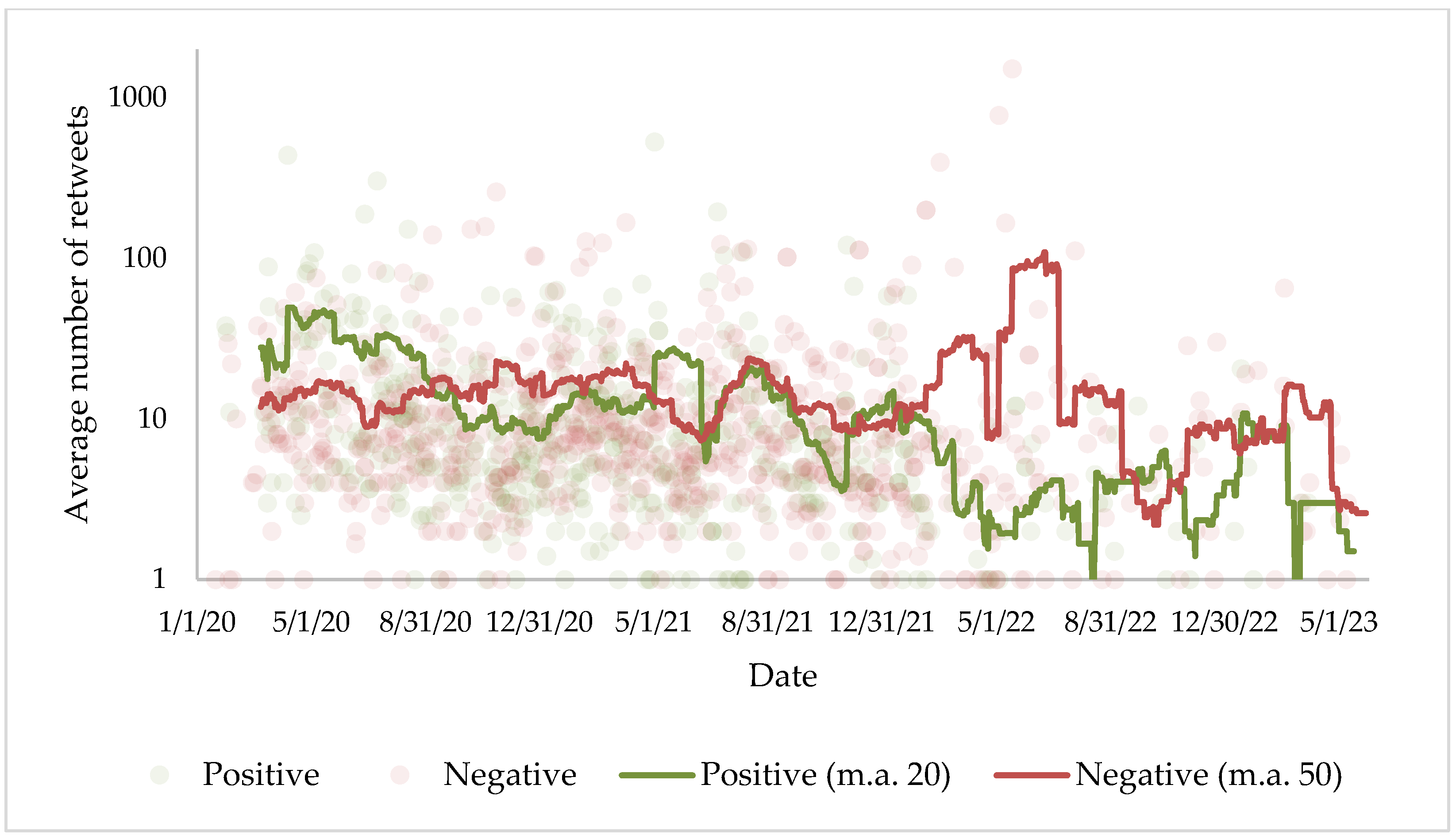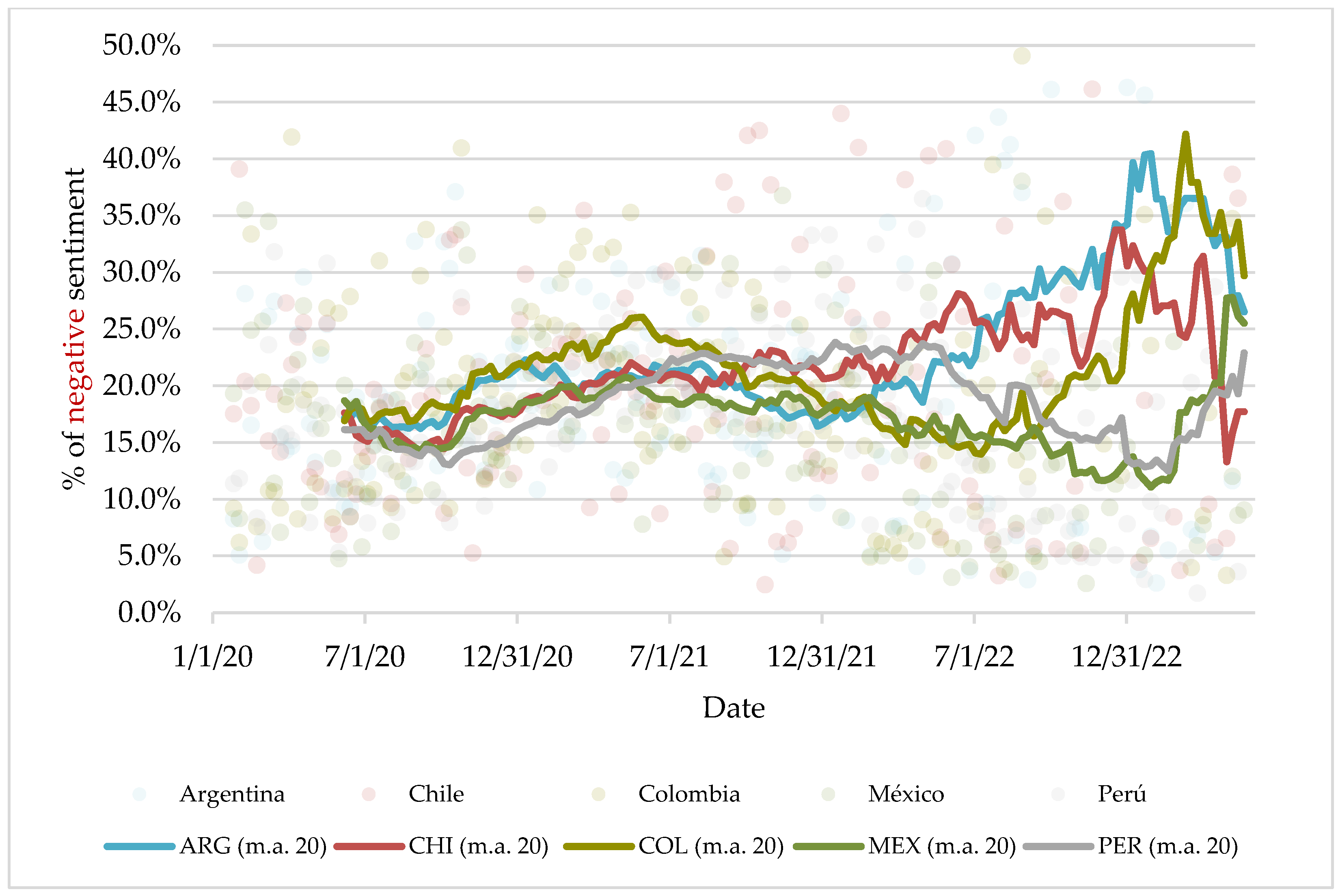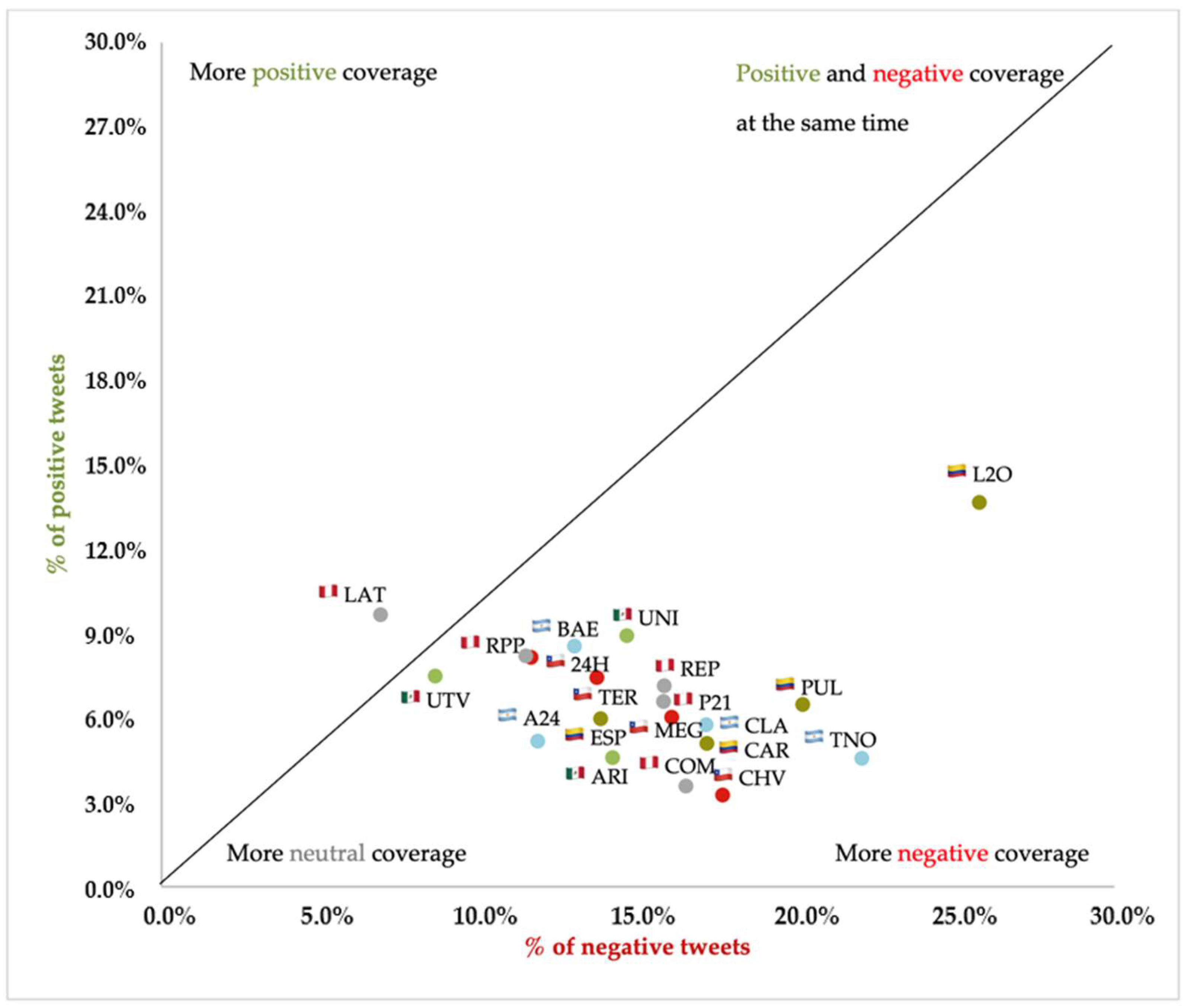Sentiment Analysis toward the COVID-19 Vaccine in the Main Latin American Media on Twitter: The Cases of Argentina, Chile, Colombia, Mexico, and Peru
Abstract
1. Introduction
1.1. Analysis of Sentiments toward COVID-19 and the Vaccine
1.2. Coverage of the Coronavirus Crisis
1.3. Objectives
2. Methodology
- Argentina: A24 online (non-governmental), Clarín online (non-governmental), Infobae (non-governmental), La Nación online (non-governmental), and TN online (non-governmental).
- Chile: 24horas online (governmental), Chvnoticias.cl (non-governmental), Emol.com (non-governmental), Laterecera.com (non-governmental), and Meganoticias.cl (non-governmental).
- Colombia: El Espectador online (non-governmental), El Tiempo online (non-governmental), Las 2 Orillas (non-governmental), Noticias Caracol TV online (non-governmental), and Pulzo (non-governmental).
- Mexico: Aristegui News (non-governmental), El Universal news online (non-governmental), Televisa news online (non-governmental), TV Azteca news online (non-governmental), and UnoTV news online (non-governmental).
- Peru: El Comercio online (non-governmental), La República online (non-governmental), Latina Noticias (non-governmental), Perú21 online (non-governmental), and RPP News online (non-governmental).
2.1. Collection and Processing of Information
2.2. Analysis
3. Results
3.1. COVID-19 Vaccines in the Latin American Media: A General Overview
3.2. Vaccine Sentiment by Country, Medium, and Platform
4. Discussion and Conclusions
Author Contributions
Funding
Institutional Review Board Statement
Informed Consent Statement
Data Availability Statement
Acknowledgments
Conflicts of Interest
References
- Rodríguez-Morales, A.J.; Viviana-Gallego, J.P.; Escalera-Antezana, C.; Méndez, A.; Zambrano, A.; Franco-Paredes, C.; Suárez, J.A.; Rodríguez-Enciso, H.D.; Ramon, G.F.; Savio-Larriera, E.; et al. COVID-19 in Latin America: The implications of the first confirmed case in Brazil. Travel Med. Infect. Dis. 2020, 35, 101613. [Google Scholar] [CrossRef]
- Forero-Peña, D.; Carrión-Nessi, F.S.; Camejo-Ávila, N.A.; Forero-Peña, M.J. COVID-19 en Latinoamérica: Una revisión sistemática de la literatura y análisis bibliométrico. Rev. Salud Pública 2020, 22, 1–7. [Google Scholar] [CrossRef]
- Pablos-Méndez, A.; Vega, J.; Aranguren, F.P.; Tabish, H.; Raviglione, M.C. COVID-19 in Latin America. BMJ 2020, 370, m2939. [Google Scholar] [CrossRef]
- Solano, A. Resilience and COVID-10. Rev. Colomb. Obstet. Ginecol. 2020, 71, 7–8. [Google Scholar] [CrossRef]
- Palomera-Chávez, A.; Herrero, M.; Carrasco-Tápias, N.E.; Juárez-Rodríguez, P.; Barrales-Díaz, C.R.; Hernández-Rivas, M.I.; Llantá-Abreu, M.C.; Lorenzana-Montenegro, L.; Meda-Lara, R.M.; Moreno-Jiménez, B. Impacto psicológico de la pandemia COVID-19 en cinco países de Latinoamérica. Rev. Latinoam. Psicol. 2021, 53, 83–93. [Google Scholar] [CrossRef]
- Harrison, C.; Horwitz, L.; Zissis, C. Cronología: Rastreando el camino hacia la vacunación en América Latina. AS/COA 2022. Available online: https://www.as-coa.org/articles/cronologia-rastreando-el-camino-hacia-la-vacunacion-en-america-latina (accessed on 13 October 2023).
- Dreser, A. Retos y avances en la vacunación contra COVID-19 en Latinoamérica y el Caribe. Salud UIS 2021, 53, e21002. [Google Scholar] [CrossRef]
- Larrondo-Ureta, A.; Peña-Fernández, S.; Morales I Gras, J. Disinformation, vaccines, and Covid-19. Analysis of the infodemic and the digital conversation on Twitter. Rev. Lat. Comun. Soc. 2021, 79, 1–18. [Google Scholar] [CrossRef]
- Casero-Ripollés, A. Impact of Covid-19 on the media system. Communicative and democratic consequences of news consumption during the outbreak. Prof. Inf. 2020, 29, e290223. [Google Scholar] [CrossRef]
- Costa-Sánchez, C.; López-García, X. Comunicación y crisis del coronavirus en España. Primeras lecciones. Prof. Inf. 2020, 29, e290304. [Google Scholar] [CrossRef]
- Lázaro-Rodríguez, P.; Herrera-Viedma, E. Noticias sobre Covid-19 y 2019-nCoV en medios de comunicación de España: El papel de los medios digitales en tiempos de confinamiento. Prof. Inf. 2020, 29, e290302. [Google Scholar] [CrossRef]
- Rosenberg, H.; Syed, S.; Rezaie, S. The Twitter pandemic: The critical role of Twitter in the dissemination of medical information and misinformation during the COVID-19 pandemic. Can. J. Emerg. Med. 2020, 22, 418–421. [Google Scholar] [CrossRef] [PubMed]
- Coombs, W.T. Ongoing Crisis Communication: Planning, Managing, and Responding, 5th ed.; Sage Publications: Newbury, CA, USA, 2019. [Google Scholar]
- Ball-Rokeach, S.J.; DeFleur, M.L. A Dependency Model of Mass-media Effects. Commun. Res. 1979, 3, 3–21. [Google Scholar] [CrossRef]
- McQuail, D.; Windahl, S. Communication Models for the Study of Mass Communication; Longman: New York, NY, USA, 1993. [Google Scholar]
- Lewison, G. The reporting of the risks from severe actute respiratory syndrome (SARS) in the news media, 2003–2004. Health Risk Soc. 2008, 10, 241–262. [Google Scholar] [CrossRef][Green Version]
- Davis, M.; Lohm, D.; Flowers, P.; Waller, E.; Stephenson, N. “We Became Sceptics”: Fear and Media Hype in General Public Narrative on the Advent of Pandemic Influenza. Sociol. Inq. 2014, 84, 499–518. [Google Scholar] [CrossRef]
- Westlund, O.; Ghersetti, M. Modelling news media use. Positing and applying the GC/MC model to the analysis of media use in everyday life and crisis situations. J. Stud. 2015, 16, 133–151. [Google Scholar] [CrossRef]
- Lubens, P. Journalists and public health professionals: Challenges of symbiotic relationship. Disaster Med. Public Health Prep. 2015, 9, 59–63. [Google Scholar] [CrossRef]
- Igartua, J.J.; Ortega-Mohedano, F.; Arcila-Calderón, C. Communication use in the times of the coronavirus. A cross-cultural study. Prof. Inf. 2020, 29, e290318. [Google Scholar] [CrossRef]
- Montaña-Blasco, M.; Ollé-Castellà, C.; Lavilla-Raso, M. Impacto de la pandemia de Covid-19 en el consumo de medios en España. Rev. Lat. Comun. Soc. 2020, 78, 155–167. [Google Scholar] [CrossRef]
- Masip, P.; Aran-Ramspott, S.; Ruiz-Caballero, C.; Suau, J.; Almenar, E.; Puertas-Graell, D. Consumo informativo y cobertura mediática durante el confinamiento por el Covid-19: Sobreinformación, sesgo ideológico y sensacionalismo. Prof. Inf. 2020, 29, e290312. [Google Scholar] [CrossRef]
- Shenton, A.; Dixon, P. Youngsters’ Use of Other People as an Information-Seeking Method. J. Librariansh. Inf. Sci. 2003, 35, 219–233. [Google Scholar] [CrossRef]
- Condeza-Dall’Orso, A.R.; Bachmann-Cáceres, I.; Mujica-Holley, C. El consumo de noticias de los adolescentes chilenos: Intereses, motivaciones y percepciones sobre la agenda informativa. Comunicar 2014, 22, 55–64. [Google Scholar] [CrossRef]
- Edson, T., Jr.; Vos, T.P. The journalist is marketing the news: Social media in the gatekeeping process. J. Pract. 2016, 10, 950–966. [Google Scholar] [CrossRef]
- Martínez-Costa, M.P.; Serrano-Puche, J.; Portilla, I.; Sánchez-Blanco, C. La interacción de los jóvenes adultos con las noticias y la publicidad online. Comunicar 2019, 27, 19–28. [Google Scholar] [CrossRef]
- Reuters Institute. Digital News Report. 2023. Available online: https://reutersinstitute.politics.ox.ac.uk/sites/default/files/2023-06/Digital_News_Report_2023.pdf (accessed on 13 October 2023).
- Jivkova-Semova, D.; Requeijo-Rey, P.; Padilla-Castillo, G. Usos y tendencias de Twitter en la campaña a elecciones generales españolas del 20D de 2015: Hashtags que fueron trending topic. Prof. Inf. 2017, 26, 824–837. [Google Scholar] [CrossRef]
- Chadwick, A. The Hybrid Media System: Politics and Power; Oxford University Press: Oxford, UK, 2017. [Google Scholar]
- Suau-Gomila, G. Microbblogging electoral: La estrategia comunicativa de Podemos yiudadanoss en Twitter en las campañas electorales del 20D y el 26J. Rev. Prism. Soc. 2020, 28, 103–126. Available online: https://revistaprismasocial.es/article/view/3389 (accessed on 13 October 2023).
- López-Meri, A.; Marcos-García, S.; Casero-Ripollés, A. What do politicians do on Twitter? Functions and communication strategies in the Spanish electoral campaign of 2016. Prof. Inf. 2017, 26, 795–804. [Google Scholar] [CrossRef]
- Pujol, F. La prensa en Twitter: Análisis de actividad e impacto en 2018. Cuad. Periodis. 2019, 38, 54–67. Available online: http://www.cuadernosdeperiodistas.com/media/2019/10/Francescpuyol_compressed.pdf (accessed on 13 October 2023).
- Córdoba-Cabús, A.; Hidalgo-Arjona, M.; López-Martín, Á. Cobertura de diarios en Twitter de las elecciones autonómicas de Madrid 2021. Procesamiento de lenguaje natural y algoritmos de aprendizaje automático. Prof. Inf. 2021, 30, e300611. [Google Scholar] [CrossRef]
- Túñez-López, M. Los periódicos en las redes sociales: Audiencias, contenidos, interactividad y estrategias comerciales. Estud. Sobre Mensaje Periodístico 2012, 18, 221–239. [Google Scholar] [CrossRef]
- Kruikemeier, S. How political candidates use Twitter and the impact on votes. Comput. Hum. Behav. 2014, 34, 131–139. [Google Scholar] [CrossRef]
- Paz-García, A.P.; Spinosa, M.M. Periodismo político en Twitter: La cobertura electoral en #CBAVota (Argentina, 2011). Cuadernos. Info 2014, 34, 133–152. [Google Scholar] [CrossRef][Green Version]
- Cambria, E. Affective Computing and Sentiment Analysis. IEEE Intell. Syst. 2016, 31, 102–107. [Google Scholar] [CrossRef]
- Hasan, A.; Moin, S.; Karim, A.; Shamshirband, S. Machine Learning-Based Sentiment Analysis for Twitter Accounts. Math. Comput. Appl. 2018, 23, 11. [Google Scholar] [CrossRef]
- Zhao, J.; Gui, X. Comparison research on text pre-processing methods on twitter sentiment analysis. IEEE Access 2017, 5, 2870–2879. [Google Scholar] [CrossRef]
- Onan, A. Sentiment analysis on product reviews based on weighted word embeddings and deep neural networks. Concurr. Comput. Pract. Exp. 2020, 33, e5909. [Google Scholar] [CrossRef]
- Pandya, V.; Somthankar, A.; Shrivastava, S.S.; Patil, M. Twitter Sentiment Analysis using Machine Learning and Deep Learning Techniques. In Proceedings of the 2021 2nd International Conference on Communication, Computing and Industry 4.0 2021, C2I4 2021, Bangalore, India, 16–17 December 2021. [Google Scholar] [CrossRef]
- Zahra, K.; Imran, M.; Ostermann, F.O. Automatic identification of eyewitness messages on twitter during disasters. Inf. Process. Manag. 2020, 57, 102107. [Google Scholar] [CrossRef]
- Bashir, S.; Bano, S.; Shueb, S.; Gul, S.; Mir, A.A.; Ashraf, R.; Shakeela; Noor, N. Twitter chirps for Syrian people: Sentiment analysis of tweets related to Syria Chemical Attack. Int. J. Disaster Risk Reduct. 2021, 62, 102397. [Google Scholar] [CrossRef]
- Agrawal, S.; Jain, S.K.; Sharma, S.; Khatri, A. COVID-19 Public Opinion: A Twitter Healthcare Data Processing Using Machine Learning Methodologies. Int. J. Environ. Res. Public Health 2023, 20, 432. [Google Scholar] [CrossRef]
- Ahmad-Mir, A.; Rathinam, S.; Gul, S. Public perception of COVID-19 vaccines from the digital footprints left on Twitter: Analyzing positive, neutral and negative sentiments of Twitterati. Libr. Tech. 2022, 40, 340–356. [Google Scholar] [CrossRef]
- Aljameel, S.S.; Alabbad, D.A.; Alzahrani, N.A.; Alqarni, S.M.; Alamoudi, F.A.; Babili, L.M.; Aljaafary, S.K.; Alshamrani, F.M. A Sentiment Analysis Approach to Predict an Individual’s Awareness of the Precautionary Procedures to Prevent COVID-19 Outbreaks in Saudi Arabia. Int. J. Environ. Res. Public Health 2021, 18, 218. [Google Scholar] [CrossRef] [PubMed]
- Behl, S.; Rao, A.; Aggarwal, S.; Chadha, S.; Pannu, H.S. Twitter for disaster relief through sentiment analysis for COVID-19 and natural hazard crises. Int. J. Disaster Risk Reduct. 2021, 55, 102101. [Google Scholar] [CrossRef]
- Hung, M.; Lauren, E.; Hon, E.S.; Birmingham, W.C.; Xu, J.; Su, S.; Hon, S.D.; Park, J.; Dang, P.; Lipsky, M.S. Social Network Analysis of COVID-19 Sentiments: Application of Artificial Intelligence. J. Med. Internet Res. 2020, 22, e22590. [Google Scholar] [CrossRef]
- Kaila, D.; Prasad, D.A. Informational Flow on Twitter—Corona Virus Outbreak-Topic Modelling Approach. Int. J. Adv. Res. Eng. Technol. 2020, 11, 128–134. Available online: https://www.scirp.org/(S(351jmbntvnsjt1aadkozje))/reference/referencespapers.aspx?referenceid=3082815 (accessed on 13 October 2023).
- Manguri, K.H.; Ramadhan, R.N.; Amin, P.R.M. Twitter Sentiment Analysis on Worldwide COVID-19 Outbreaks. Kurd. J. Appl. Res. 2020, 2020, 54–65. [Google Scholar] [CrossRef]
- Boon-Itt, S.; Skunkan, Y. Public Perception of the COVID-19 Pandemic on Twitter: Sentiment Analysis and Topic Modeling Study. JMIR Public Health Surveill 2020, 6, E21978. [Google Scholar] [CrossRef]
- Yousefinaghani, S.; Dara, R.; Mubareka, S.; Apadopoulos, A.; Sharif, S. An analysis of COVID-19 vaccine sentiments and opinions on Twitter. Int. J. Infect. Dis. 2021, 108, 256. [Google Scholar] [CrossRef]
- Jalil, Z.; Abbasi, A.; Javed, A.R.; Badruddin-Khan, M.; Abul-Hasanat, M.H.; Malik, K.M.; Saudagar, A.K.J. COVID-19 Related Sentiment Analysis Using State-of-the-Art Machine Learning and Deep Learning Techniques. Front. Public Health 2022, 9, 812735. [Google Scholar] [CrossRef]
- Hussain, A.; Tahir, A.; Hussain, Z.; Sheikh, Z.; Gogate, M.; Dashtipour, K.; Ali, A.; Sheikh, A. Artificial Intelligence-Enabled Analysis of Public Attitudes on Facebook and Twitter Toward COVID-19 Vaccines in the United Kingdom and the United States: Observational Study. J. Med. Internet Res. 2021, 23, e26627. [Google Scholar] [CrossRef]
- Ruiz-Núñez, C.; Segado-Fernández, S.; Jiménez-Gómez, B.; Jiménez-Hidalgo, P.J.; Romero-Magdalena, C.S.; Águila-Pollo, M.C.; Santillán-García, A.; Herrera-Peco, I. Bots’ Activity on COVID-19 Pro and Anti-Vaccination Networks: Analysis of Spanish-Written Messages on Twitter. Vaccines 2022, 10, 1240. [Google Scholar] [CrossRef]
- Prada, E.; Langbecker, A.; Catalan-Matamoros, D. Public discourse and debate about vaccines in the midst of the covid-19 pandemic: A qualitative content analysis of Twitter. Vaccine 2023, 41, 3196–3203. [Google Scholar] [CrossRef] [PubMed]
- Christensen, B.; Laydon, D.; Chelkowski, T.; Jemielniak, D.; Vollmer, M.; Bhatt, S.; Krawczyk, K. Quantifying Changes in Vaccine Coverage in Mainstream Media as a Result of the COVID-19 Outbreak: Text Mining Study. JMIR Infodemiology 2022, 2, e35121. [Google Scholar] [CrossRef]
- Teneva, E.V. Digital Pseudo-Identification in the Post-Truth Era: Exploring Logical Fallacies in the Mainstream Media Coverage of the COVID-19. Vaccines 2023, 12, 457. [Google Scholar] [CrossRef]
- Jun, J.; Zain, A.; Chen, Y.; Kim, S.-H. Adverse Mentions, Negative Sentiment, and Emotions in COVID-19 Vaccine Tweets and Their Association with Vaccination Uptake: Global Comparison of 192 Countries. Vaccines 2022, 10, 735. [Google Scholar] [CrossRef]
- Jemielniak, D.; Krempovych, Y. An analysis of AstraZeneca COVID-19 vaccine misinformation and fear mongering on Twitter. Public Health 2021, 200, 4–6. [Google Scholar] [CrossRef] [PubMed]
- Zúñiga-Morales, L.; Zúñiga-López, A.; Villegas-Cortez, J.; Avilés-Cruz, C.; Morales-Torres, F. Análisis preliminar del sentimiento sobre la vacunación del COVID-19 en México. Res. Comput. Sci. 2021, 150, 281–294. Available online: https://www.researchgate.net/publication/371575120_Analisis_preliminar_del_sentimiento_sobre_la_vacunacion_del_COVID-19_en_Mexico (accessed on 13 October 2023).
- Alcocer-Carranza, J.; Gonzalez-Carlo, A.L.; Reyna-Avila, L.; Peña-Marcial, E.; Pérez-Cabañas, R. Actitud ante la vacuna contra COVID-19 de los habitantes del estado de Guerrero, México. Univ. Salud 2022, 24, 108–116. [Google Scholar] [CrossRef]
- Salcedo-Lagos, P.A.; Kotz-Grabole, G.E.; Vergara-Espinoza, C.M.; Sánchez-Hechavarría, M.E. Análisis de sentimiento de tweets sobre la vacuna contra el COVID-19 en países iberoamericanos hispanohablantes. Rev. Latinoam. Psicol. 2022, 54, 1–11. [Google Scholar] [CrossRef]
- Rodríguez-Orejuela, A.; Montes-Mora, C.L.; Osorio-Andrade, C.F. Sentimientos hacia la vacunación contra la covid-19: Panorama colombiano en Twitter. Palabra Clave 2022, 25, 2027–2534. [Google Scholar] [CrossRef]
- Xavier, P.; Cabrera, V.; Salgado, M.F. Análisis de Sentimientos Sobre la Vacuna Para COVID-19 en la Red Social “Twitter” en el Contexto Ecuatoriano. Master’s Thesis, Universidad del Azuay, Cuenca, Ecuador, 2022. Repositorio Institucional. Available online: http://dspace.uazuay.edu.ec/handle/datos/11709 (accessed on 13 October 2023).
- Duc-Huynh, T.L. The COVID-19 risk perception: A survey on socioeconomics and media attention. Econ. Bull. 2020, 40, 758–764. Available online: https://www.researchgate.net/publication/340172488_The_COVID-19_risk_perception_A_survey_on_socioeconomics_and_media_attention (accessed on 13 October 2023).
- Zunino, E.; Arcangeletti-Yacante, C.A. La Cobertura Mediática de la COVID-19 en la Argentina: Un Estudio Sobre el Tratamiento Informativo de la Pandemia en los Principales Medios Online del país. Prácticas Oficio 2021, 25, 49–66. Available online: https://ri.conicet.gov.ar/handle/11336/121490 (accessed on 13 October 2023).
- Zunino, E. Medios digitales y COVID-19: Sobreinformación, polarización y desinformación. Universitas 2021, 34, 133–154. [Google Scholar] [CrossRef]
- Muñiz, C. Media System Dependency and Change in Risk Perception During the COVID-19 Pandemic. Trípodos 2020, 47, 11–26. Available online: https://dialnet.unirioja.es/servlet/articulo?codigo=7756561&info=resumen&idioma=ENG (accessed on 13 October 2023). [CrossRef]
- Muñiz, C.; Corduneanu, V.I. Percepción de riesgo y consumo mediático durante el inicio de la pandemia de COVID-19 en México. Más Poder Local 2020, 41, 44–47. Available online: https://dialnet.unirioja.es/servlet/articulo?codigo=7407223&info=resumen&idioma=ENG (accessed on 13 October 2023).
- López, A.M.; Moreno, P.d.C.; Mera, J.M.B. Tratamiento informativo y competencias mediáticas sobre la COVID-19 en Ecuador. Rev. Comun. 2021, 20, 137–152. [Google Scholar] [CrossRef]
- Garcés-Prettel, M.; Navarro-Díaz, L.R.; Jaramillo-Echeverri, L.G.; Santoya-Montes, Y. Representaciones sociales de la recepción mediática durante la cuarentena por la COVID-19 en Colombia: Entre mensajes y significados. Cad. Saúde Pública 2021, 37, e00203520. [Google Scholar] [CrossRef] [PubMed]
- Data Bank. Total Population—Latin America & Caribbean 2021. Available online: https://datos.bancomundial.org/indicador/SP.POP.TOTL?locations=ZJ (accessed on 13 October 2023).
- Barbieri, F.; Espinosa-Anke, L.; Camacho-Collados, J. XLM-T: Multilingual Language Models in Twitter for Sentiment Analysis and Beyond. In Proceedings of the 13th Conference on Language Resources and Evaluation 2022, Marseille, France, 20–25 June 2022; pp. 258–266. [Google Scholar] [CrossRef]
- Bonnevie, E.; Gallegos-Jeffrey, A.; Goldbarg, J.; Byrd, B.; Smyser, J. Quantifying the rise of vaccine opposition on Twitter during the COVID-19 pandemic. J. Commun. Healthc. 2021, 14, 12–19. [Google Scholar] [CrossRef]





| Variables | Type |
|---|---|
| User | String |
| Date of publication | DateTime |
| Number of retweets | Scale |
| Number of likes | Scale |
| Number of quotes | Scale |
| Number of replies | Scale |
| Raw text | String |
| Country | N | Positive | Neutral | Negative |
|---|---|---|---|---|
| Argentina | 4237 | 7.2% | 78.0% | 14.9% |
| Chile | 3265 | 6.6% | 79.0% | 14.5% |
| Colombia | 3778 | 6.5% | 77.8% | 15.7% |
| Mexico | 4133 | 7.7% | 79.1% | 13.3% |
| Peru | 8830 | 5.9% | 78.9% | 15.2% |
| Platform | N | Positive | Neutral | Negative |
| Press | 17,688 | 6.6% | 78.1% | 15.4% |
| Television | 5099 | 6.3% | 80.0% | 13.7% |
Disclaimer/Publisher’s Note: The statements, opinions and data contained in all publications are solely those of the individual author(s) and contributor(s) and not of MDPI and/or the editor(s). MDPI and/or the editor(s) disclaim responsibility for any injury to people or property resulting from any ideas, methods, instructions or products referred to in the content. |
© 2023 by the authors. Licensee MDPI, Basel, Switzerland. This article is an open access article distributed under the terms and conditions of the Creative Commons Attribution (CC BY) license (https://creativecommons.org/licenses/by/4.0/).
Share and Cite
Córdoba-Cabús, A.; García-Borrego, M.; Ceballos, Y. Sentiment Analysis toward the COVID-19 Vaccine in the Main Latin American Media on Twitter: The Cases of Argentina, Chile, Colombia, Mexico, and Peru. Vaccines 2023, 11, 1592. https://doi.org/10.3390/vaccines11101592
Córdoba-Cabús A, García-Borrego M, Ceballos Y. Sentiment Analysis toward the COVID-19 Vaccine in the Main Latin American Media on Twitter: The Cases of Argentina, Chile, Colombia, Mexico, and Peru. Vaccines. 2023; 11(10):1592. https://doi.org/10.3390/vaccines11101592
Chicago/Turabian StyleCórdoba-Cabús, Alba, Manuel García-Borrego, and Yaiza Ceballos. 2023. "Sentiment Analysis toward the COVID-19 Vaccine in the Main Latin American Media on Twitter: The Cases of Argentina, Chile, Colombia, Mexico, and Peru" Vaccines 11, no. 10: 1592. https://doi.org/10.3390/vaccines11101592
APA StyleCórdoba-Cabús, A., García-Borrego, M., & Ceballos, Y. (2023). Sentiment Analysis toward the COVID-19 Vaccine in the Main Latin American Media on Twitter: The Cases of Argentina, Chile, Colombia, Mexico, and Peru. Vaccines, 11(10), 1592. https://doi.org/10.3390/vaccines11101592








